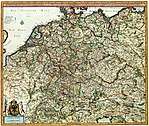Timeline of Chemnitz
Prior to 20th century
Part of a series on the |
||||||||||
|---|---|---|---|---|---|---|---|---|---|---|
| History of Germany | ||||||||||
 | ||||||||||
| Topics | ||||||||||
| Early history | ||||||||||
| Middle Ages | ||||||||||
| Early Modern period | ||||||||||
| Unification | ||||||||||
|
||||||||||
| German Reich | ||||||||||
|
||||||||||
| Contemporary Germany | ||||||||||
|
||||||||||
|
| ||||||||||
- 1136 - Benedictine monastery founded near Chemnitz.[1]
- 1143 - Chemnitz "becomes a market town."[1]
- 1398 - Paper mill established.[2]
- 1466 - Population: 3,455.
- 1498 - Town Hall built near the Markt (Chemnitz).
- 1539 - Protestant Reformation.[1]
- 1551 - Population: 5,616.
- 1630 - Battle of Chemnitz.
- 1700 - Population: 4,873.
- 1801 - Population: 10,835.
- 1811 - Schwalbe manufactory in business (later Chemieanlagenbau Chemnitz engineering firm).
- 1833 - Chemnitz City Orchestra formed.[3]
- 1836 - Royal Mercantile College established.
- 1840 - Population: 23,476.[4]
- 1852 - Chemnitz Hauptbahnhof opens.
- 1864 - Population: 54,827.[4]
- 1868 - Museum für Naturkunde Chemnitz founded.
- 1869 - Volksbank Chemnitz (bank) founded.
- 1878 - Jewish Cemetery, Chemnitz in use (approximate date).
- 1880
- 1884 - Chemnitz Tar Mummy discovered.
- 1885 - Population: 110,817.[5]
- 1888 - St. Peter's Church, Chemnitz built.
- 1890 - Population: 138,954.[4]
- 1893 - Electric tram begins operating.
- 1899 - Chemnitz Synagogue built.
20th century

Arbeiterfestspiele participants in front of City Hall, 1960
- 1905 - Population: 244,927.[6]
- 1907 - Bernsdorf becomes part of city.
- 1909
- Chemnitz Opera hall built.
- König-Albert-Museum (Chemnitz) opens.
- 1910 - Johann-Wolfgang-von-Goethe-Gymnasium (school) established.
- 1911 - New City Hall, Chemnitz built.
- 1913 - Borna-Heinersdorf becomes part of city.
- 1919 - Population: 303,775.[7]
- 1920 - Chemnitzer Polizeisportverein sport club formed.
- 1926 - Südkampfbahn stadium opens.
- 1933 - Theaterplatz (Chemnitz) renamed "Adolf Hitler Platz".
- 1934 - Stadion an der Gellertstraße (stadium) opens.
- 1938 - 9 November: Kristallnacht antisemitic unrest; synagogue destroyed.
- 1945
- Bombing of Chemnitz in World War II.
- City becomes part of East Germany.
- 1946 - Population: 250,188.
- 1947 - Wismut (mining company) headquartered in Chemnitz.
- 1950 - Adelsberg becomes part of city.
- 1953 - City renamed "Karl-Marx-Stadt".
- 1955 - Chemnitz Botanical Garden rebuilt.[8]
- 1959 - Red Tower, Chemnitz reconstructed.
- 1960 - Arbeiterfestspiele (workers' cultural festival) held.
- 1961
- HKW Chemnitz-Nord power station begins operating.
- City twinned with Tampere, Finland.
- 1966
- Chemnitzer FC (football club) formed.
- City twinned with Ljubljana, Yugoslavia.
- 1967 - City twinned with Arras, France.
- 1968 - City twinned with Timbuktu, Mali.
- 1970 - City twinned with Ústí nad Labem, Czechoslovakia.
- 1971 - 9 October: Karl Marx Monument unveiled.[9]
- 1972
- City twinned with Łódź, Poland.
- Population: 301,502.
- 1974 - Wohngebiet Fritz Heckert (housing) construction begins.
- 1990
- City renamed "Chemnitz".
- Chemnitzer Verkehrs-Aktiengesellschaft (transit entity) established.
- Population: 294,244.
- 1991 - Annual "Days of Jewish Culture" begins.[10]
- 1993 - Peter Seifert becomes mayor.
- 1997 - City-Bahn Chemnitz (transit entity) established.
- 1999 - Röhrsdorf and Wittgensdorf become part of city.
21st century
- 2001 - Villa Esche restored as a cultural space.[9]
- 2003 - Chemnitz Industrial Museum opens.
- 2006 - Barbara Ludwig becomes mayor.
- 2007 - Gunzenhauser Museum opens.[9]
- 2010 - Population: 243,248.
- 2012 - Thor Steinar "Brevik" shop in business.[11]
- 2014 - March: Neo-Nazi Nationale Sozialisten Chemnitz group banned.
See also
- Chemnitz history
- History of Chemnitz
- List of mayors of Chemnitz
- List of heritage sites in Chemnitz
Other cities in the state of Saxony:
References
- Britannica 1910.
- Wilhelm Sandermann (2013). "Beginn der Papierherstellung in einigen Landern". Papier: Eine spannende Kulturgeschichte (in German). Springer-Verlag. ISBN 978-3-662-09193-7. (timeline)
- Colin Lawson, ed. (2003). "Orchestras Founded in the 19th Century (chronological list)". Cambridge Companion to the Orchestra. Cambridge University Press. ISBN 978-0-521-00132-8.
- Brockhaus 1896.
- "German Empire: Area and Population: Principal Towns". Statesman's Year-Book. London: Macmillan and Co. 1890.
- "Germany". Statesman's Year-Book. London: Macmillan and Co. 1908.
- "Germany: Area and Population: Principal Towns". Statesman's Year-Book. London: Macmillan and Co. 1921 – via HathiTrust.
- "Garden Search: Germany". London: Botanic Gardens Conservation International. Retrieved 30 November 2015.
- "In Germany, an Unlikely Art Hub Honed by Enthusiasm", New York Times, 27 July 2012
- "Kurt Weill's Heritage: Honor Replaces Scorn; A German City Performs His Jewish Opera", New York Times, 28 June 1999
- "Furore over German 'Brevik' clothing shop in Chemnitz", BBC News, 6 March 2012
This article incorporates information from the German Wikipedia.
Bibliography
in English
- "Chemnitz". Handbook for North Germany. London: J. Murray. 1886.
- "Chemnitz". Chambers's Encyclopaedia. London. 1901.
- "Chemnitz", Northern Germany (15th ed.), Leipzig: Karl Baedeker, 1910, OCLC 78390379
- "Chemnitz", Encyclopædia Britannica (11th ed.), New York, 1910, OCLC 14782424
in German
- C. W. Zoellner (1886). Geschichte der Fabrik- und Handelsstadt Chemnitz.
- "Chemniz". Brockhaus' Konversations-Lexikon (in German) (14th ed.). Leipzig: Brockhaus. 1896.
- P. Krauss und E. Uetrecht, ed. (1913). "Chemnitz". Meyers Deutscher Städteatlas [Meyer's Atlas of German Cities] (in German). Leipzig: Bibliographisches Institut.
- Harald Weber. Aus der Geschichte von Chemnitz und Umgebung. Verlag für sächsische Regionalgeschichte, Nördlingen 2000, ISBN 3-9805106-3-8.
External links
| Wikimedia Commons has media related to Chemnitz. |
- Links to fulltext city directories for Chemnitz via Wikisource
- Europeana. Items related to Chemnitz, various dates.
- Digital Public Library of America. Items related to Chemnitz, various dates
This article is issued from Wikipedia. The text is licensed under Creative Commons - Attribution - Sharealike. Additional terms may apply for the media files.